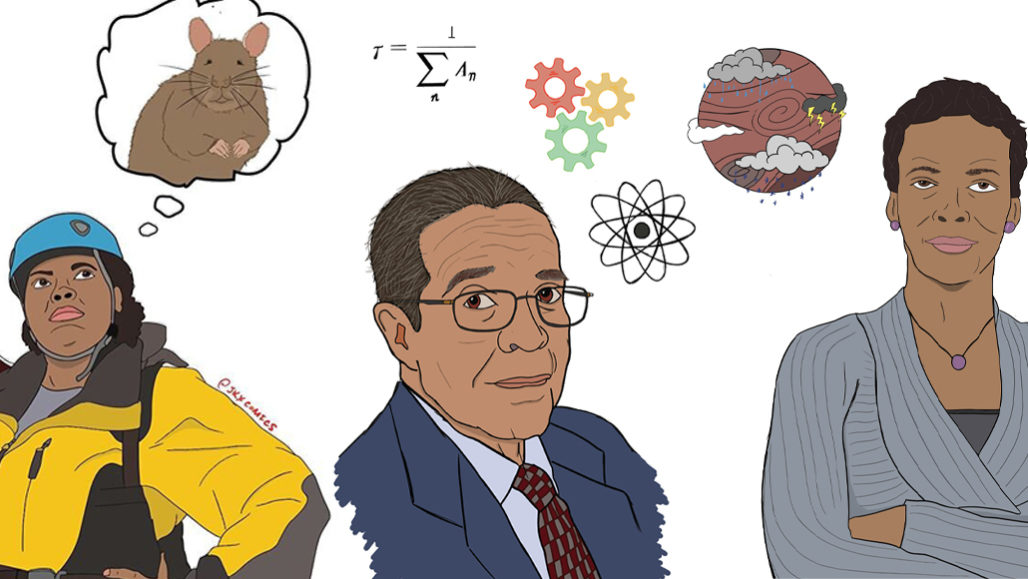The superheroes in these comics were inspired by real scientists
PhD students tell stories that teach science through cartoons

JKX Comics turns complex science — and its jargon — into bite-sized comics for middle- and high-school students. These images were made to celebrate Black History Month. They depict ecologist Danielle Lee (left), mathematician and physicist J. Ernest Wilkins Jr. (middle) and astrophysicist Aomawa Shields (right).
Khoa Tran
By Kyle Plantz
Jaye Gardiner loves comic books. She also loves science. Sensing an opportunity, she decided to combine the two.
In 2015, she and two friends — Khoa Tran and Kelly Montgomery — founded an online publishing company called JKX Comics. At the time, all three were pursuing PhDs in science at the University of Wisconsin–Madison. Each knew how tough it can be to explain research and to engage students in its details.
So they decided to use a cartoon format and light humor. The three spent weekends at a campus bar writing the text and drawing panels for their first comic book, which came out in 2016. This comic, EBV and the Replication Dance, describes how the common Epstein-Barr virus copies itself. The online book’s storyline: a virus goes clubbing with friends. Their venue is a human cell.
The colorful visuals help illustrate the science, explains Tran. “Then you also have that story element,” he points out. Comics are “a way of opening that door into what science is.” Through comics, his JKX colleagues hope to “inspire the next generation to pursue STEM [science, technology, engineering and math].” Today, Tran works at the University of Pennsylvania in Philadelphia where he conducts research on epigenetics.
He, Gardiner and Montgomery are not alone in seeing a place for science in the comic universe. A lot of research has suggested that comics can introduce a wide and diverse group of people to science subjects, according to a 2018 review of such studies. And comics can make information more accessible by presenting it through both text and pictures.

In 2018, seven more scientists at UW–Madison joined the JKX Comics crew. In all, they brought together fields as diverse as psychology, astronomy and microbiology. The scientists then drafted local artists to help illustrate the research they wanted to depict. And the 11 comics they have developed thus far are now being offered online for free.
What’s in it for the scientists? “We can show who the scientists are … that they are also just people,” says Gardiner. She’s now a cancer biologist at the Fox Chase Cancer Center in Philadelphia, Pa. “We’re not all geniuses with Einstein-like hair that are antisocial,” she notes. Her team shows that those “eureka!” moments don’t happen all the time. “Using comics,” she says, “is a nice way to tell their story” — the real story.
Finding a way to tell the story
They released their latest comic on March 2. Called Gilbert’s Glitch Switch, it shows a biochemist getting sucked into a video game. There, Gilbert uses amino acids to get proteins to communicate with each other. The panels are drawn in the style of the classic video game Super Mario Bros. The storyline explains fundamental concepts in biochemistry, says Montgomery, who is its author. In real life, she also is a chemical biologist at the University of California, San Francisco.
By understanding how proteins communicate, she explains, you can learn how to modify a protein so that it “will be able to communicate to its neighbor better.” Scientists use this knowledge to help stop certain diseases that develop when proteins communicate in the wrong way. Among these, she notes, is Alzheimer’s and Charcot-Marie-Tooth disease. That last one causes nerve damage in the arms and legs.
Translating a complex science topic into a comic can be challenging. The creators have to not only be accurate but also tell an engaging story. The idea, he explains, is to trigger a “curiosity in people to then learn more and further investigate the topic.”
In the future
The team has geared its comics toward middle-school students. Yet they hope people of all ages will enjoy them and learn from them. Tran, Gardiner and Montgomery are creating a Kickstarter campaign. The money they raise would go to printing versions of their comics that would be handed out to underserved children in and around Madison, Wisc., through what is known as the Madison Reading Project. JKX also is at work on a new comic series about women in STEM. A second series will investigate diseased organs. They view it as a tribute to television’s CSI series. (That show on criminal forensics began in 2000 and ran for 15 years.)
There’s a lot of misinformation and fake news circulating around the internet. Some of it “scares people away from science,” Montgomery says. The goal of the new comics is to “limit some of those misunderstandings,” she adds. “I think that would be a really positive impact.”







